
Stockmann plc is a Finnish retailer established in 1862.

Katajanokka is a neighbourhood of Helsinki, Finland, with around 4000 inhabitants in 2005. The district is located adjacent to the immediate downtown area, though in the first major town plan for Helsinki from the mid-18th century, the area fell outside the fortifications planned to encircle the city.

Lauttasaari is an island in Helsinki, Finland, about 3 kilometres (1.9 mi) west of the city centre. Together with some surrounding unpopulated small islands, Lauttasaari is also a district of Helsinki. With 23,226 residents as of 2017, the island is Finland's second largest by population, after Fasta Åland. Its land area is 3.85 km2.
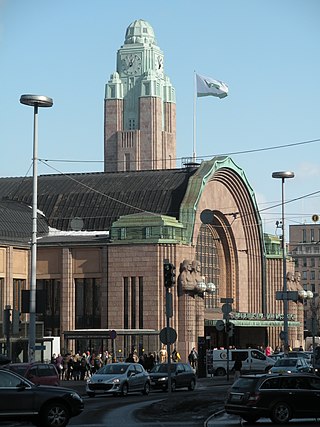
Helsinki Central Station (HEC) is the main station for commuter rail and long-distance trains departing from Helsinki, Finland. The station is used by approximately 400,000 people per day, of whom about 200,000 are passengers. It serves as the terminus for all trains in the Helsinki commuter rail network, as well as for all Helsinki-bound long-distance trains in Finland. The Rautatientori metro station is located in the same building.

The City-Center was a plan to raze and rebuild the block between the central Helsinki streets of Kaivokatu, Keskuskatu and Aleksanterinkatu, creating a unified, modern appearance for the area. The plan was originally drafted between 1958 and 1960 by Viljo Revell; Heikki Castrén continued work on the plan after Revell's death in 1964. The fulfillment of the plan would have required the demolition of several old buildings that are today considered to be a vital part of Helsinki's heritage.

Aleksanterinkatu is a street in Kluuvi, the commercial centre of Helsinki, Finland. In the city plan by Carl Ludvig Engel, it was the Decumanus Maximus, the main east–west street in the city, crossing the Cardo, Unioninkatu (Union Street) at the corner of the Senate Square.

Esplanadi, colloquially known as Espa, is an esplanade and urban park in downtown Helsinki, Finland, situated between the Erottaja square and the Market Square. It is bordered on its northern and southern sides by the Pohjoisesplanadi and Eteläesplanadi streets, respectively. Aleksanterinkatu runs parallel to Esplanadi. Esplanadi is well known as a popular walking area, and street performances are also often held in the park.
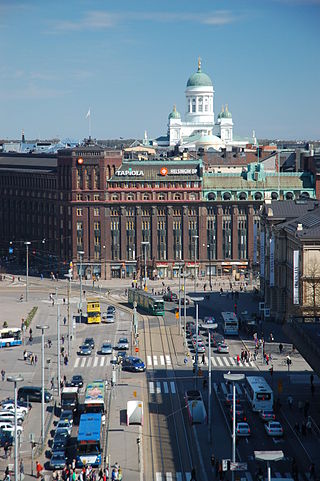
Kluuvi is the commercial centre of Helsinki, Finland, and a neighbourhood in the Vironniemi district of Helsinki. The Helsinki Central railway station, Hotel Kämp and Hotel Arthur, the Helsinki main post office, the Stockmann and Sokos department stores, the Kluuvi shopping centre and the main offices of Finnish banks are located in Kluuvi. Kluuvi includes the central campus of the University of Helsinki, the Ateneum art museum, and the movie theatres Maxim, Kinopalatsi and Bristol. The northeastern part of Kluuvi, which includes the Kaisaniemi park, is commonly called Kaisaniemi, but it is not the official name of any neighbourhood in Helsinki.

Stockmann Helsinki Centre is a culturally significant business building and department store located in the centre of Helsinki, Finland. It is one of many department stores owned by the Stockmann corporation. It is the largest department store in the Nordic countries in terms of area and total sales. The store is known for carrying all the internationally recognised luxury brands, and Stockmann's enjoys a reputation as the primary high-end department store in Finland. Stockmann Delicatessen, the food and beverage department located at the basement level, is renowned for the quality and choice of its foodstuffs. The Stockmann logo represents a set of escalators, which are commonly, but wrongly believed represent the first escalators in Finland. The first escalators in Finland were installed in the Forum department store, Turku (1926).
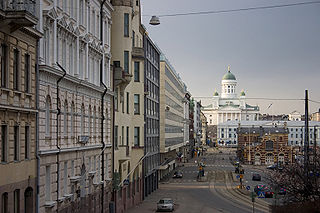
Kaartinkaupunki is a neighbourhood in the southern part of Helsinki, Finland.

Munkkiniemi is a neighbourhood in Helsinki. Subdivisions within the district are Vanha Munkkiniemi, Kuusisaari, Lehtisaari, Munkkivuori, Niemenmäki and Talinranta.
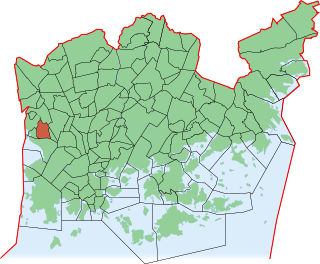
Munkkivuori is a quarter of the Munkkiniemi neighbourhood in Helsinki. The buildings and the plan of site are typical of the late 1950s. Most of the residential buildings in Munkkivuori are within a loop formed by Ulvilantie ring road. The automotive traffic to the residential buildings is routed along Ulvilantie whereas Raumantie no through road terminating in the center of the Ulvilantie loop provides access to public services and limits the through-traffic in residential areas. A designed network of crushed stone walkways provides easy accessibility around Munkkivuori for cyclists, pedestrians and other non-automotive traffic.

Villa Hakasalmi, also known as Villa Karamzin, is an architecturally and historically important 19th-century villa located in the Etu-Töölö district of central Helsinki, Finland. The villa is situated in a prominent position on Mannerheimintie, next to Finlandia Hall and opposite the National Museum.

Domus Litonii is a three-story Empire style residential, commercial and office building with a lower bazaar wing located at Aleksanterinkatu 50 in central Helsinki, Finland.

Tuomiokirkonkatu is a north–south street in the center of Tampere, Finland, which runs through the districts of Jussinkylä and Kyttälä. The street is about a kilometer long. In the north it ends at Lapintie, in the south Vuolteenkatu. In Kyttälä, part of Tuomiokirkonkatu has been turned into a pedestrian street. In the future, the pedestrian section will be expanded so that it will eventually extend south from Kyttälänkatu to Suvantokatu and the Sori Square.
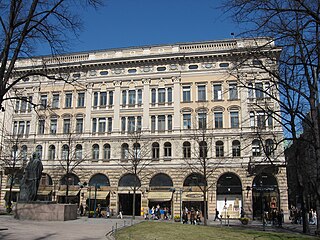
The Wrede passage, also known as the "Old merchant alley" or the "Grandma tunnel" is an entity formed by two stone buildings in Kluuvi, Helsinki, Finland. The name refers also to the merchant alley stretching throughout the block. The passage is formed by the Wrede house in the corner between Pohjoisesplanadi and Mikonkatu and the Central house in the corner between Aleksanterinkatu and Mikonkatu. The building entity represents Renaissance Revival architecture and was designed and partly commissioned by architect Karl August Wrede, and built in 1888 and 1892.

The Eliel Square is a square on the west side of the Helsinki Central Station in the heart of Helsinki, Finland. It is named after the railway station designer Eliel Saarinen. The square is for the most part the departure and arrival platforms for regional buses.

The Lundqvist Building is a former department store in the Kluuvi district of central Helsinki, Finland. It is located at the intersection of Aleksanterinkatu and Mikonkatu streets. Until the end of 2020, it housed the Aleksi 13 department store, but is now the home of Glasshouse Helsinki, a boutique for ecologically-minded fashion. Its architecture represents a transition from the revivalism of the nineteenth century to Art Nouveau and advanced construction techniques at the dawn of the twentieth.

Mikonkatu is a street in central Helsinki, Finland, leading north from the Esplanadi Park to the Kaisaniemi Park, mostly converted into a pedestrian street in 1992.

Kirjatalo is a commercial building located on the corner of Pohjoisesplanadi and Keskuskatu in central Helsinki, Finland. It is notable for having been designed by Alvar Aalto. Possibly its best-known resident is the flagship store of the Academic Bookstore chain.






















